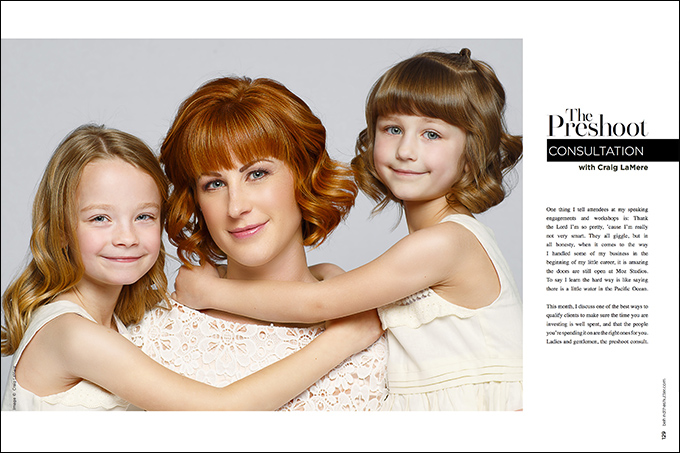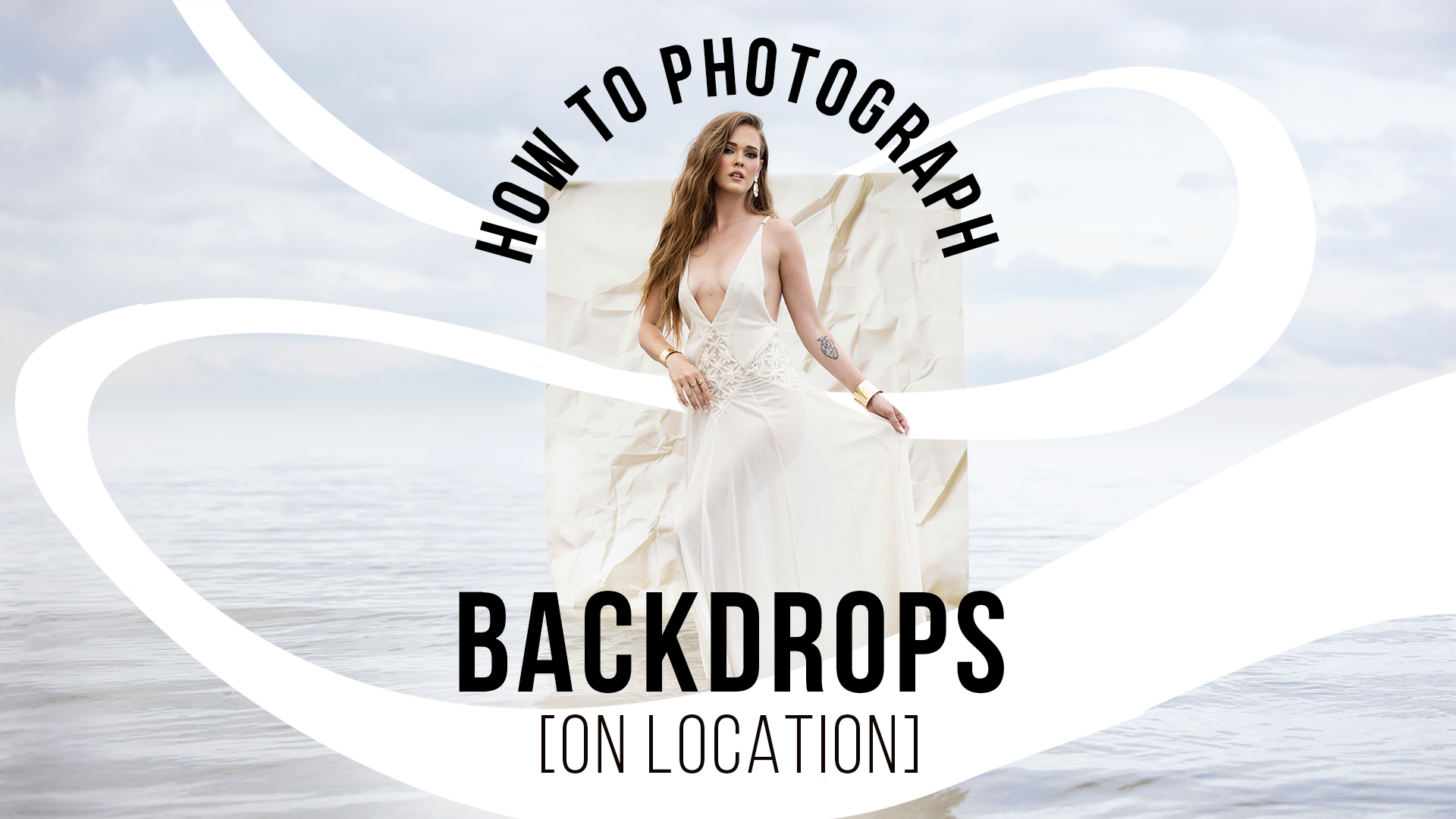The Preshoot Consultation with Craig LaMere
One thing I tell attendees at my speaking engagements and workshops is: Thank the Lord I’m so pretty, ’cause I’m really not very smart. They all giggle, but in all honesty, when it comes to the way I handled some of my business in the beginning of my little career, it is amazing the doors are still open at Moz Studios. To say I learn the hard way is like saying there is a little water in the Pacific Ocean.
This month, I discuss one of the best ways to qualify clients to make sure the time you are investing is well spent, and that the people you’re spending it on are the right ones for you. Ladies and gentlemen, the preshoot consult.
Setting Up the Consult
When I first started shooting, I took any and all clients who were willing to drop some cash. People called asking how cheap I was, and, because I was so cheap, they booked on the spot, no questions asked. I put them in the books, and the next contact would be when they walked in the studio doors for their shoot.
Most of the time it was cool, with no issues, but when it was not cool, it was monumentally bad. Most of the issues were due to a lack of communication on my part, due to just saying yes to business rather than qualifying the right clients—or, worse, not learning the expectations of good clients and failing them. The worst situation was when, about five minutes into the shoot, I realized we were not compatible in the least and now we were both stuck in a situation we shouldn’t have been in. After a few of those, I got a little smarter and decided it would be a good idea to get to know potential clients before committing to anything.
These days when I get phone call inquiring about sessions or pricing, the first thing I do is offer a consultation meeting at the studio. For email inquiries, I write them to see when a good time would be to call and chat about their session. When I get the number and the time, I call and set up the consultation. The conversation is very simple, but it is the best tool for weeding out suspects who are only price shopping or who are not serious about booking, from actual prospects who are ready to commit to a session.
I ask potential clients to come into the studio so we can go over the pricing structure and so we can show them all our products. I tell them it is important to see the product so that when we pick out their images, they have a good idea what it is they want to purchase and that we may have some really cool options for them that they did not even know about.
It’s at this point I say, “Cool, when can we schedule your consult?” Here is where the rubber hits the road. You will know if you have a serious prospect or someone who is not ready to be a client. As the saying goes, “First one to speak loses.” You literally just sit there until you get a response. Most of the time the answer is immediate, but sometimes it seems like an eternity before the person on the other end of the phone says anything.
Be patient, and it will come. If they say, “Sweet, let’s set up a time,” then you set it up; but if they say, “I have to talk to my wife” or, “I will get back with you,” chances are they are not ready, which is supercool because you found out in five seconds who you are dealing with. Now that you have the consult set up, you are in the driver’s seat. You will show this client the best time they have ever had, and you will set yourself up for a killer sale.
The Consult
The consult has four parts to it. There is the interview, product acclimation, the decision—and finally the taking of the cash.
- The Interview
The interview is the part of the consult that is by far the most valuable. There is a number of things you will find out in the interview that will dictate your choices at the shoot—or, for that matter, if there is even going to be a shoot, but we will get to that in a minute.
The first thing I do before I open my big mouth is take a few minutes to just check out my possible client. If you sit back for a moment and observe, you will get a really good idea fast about whom you have in front of you. You will get a good idea if she is more conservative or wild, or if she is more fancy or more casual.
Then I start asking questions. How many people are in the party? Are there any little kids or babies? Is there more than one family unit? If you have a group with little kids, you have about a 10- to 15-minute window to get the main group shot before you lose the kids and the session. The reason you ask about the units is because if they want all the units shot, you have to account for the time. I want to know the size of the main group, because that starts the posing gears turning in my head, and I will know if I have to get seating. I ask them if they like more natural or urban settings. I ask if they like brighter or cooler colors. There are a lot more questions I ask, but you get the idea.
The interview is also the time when the client gets to meet me. This is the dealmaker or breaker. A lot of people are familiar with my work, and not so familiar with me. So the interview is where the client gets to know who I am as a person, not just a shooter. I wear my official Moz uniform so they get a good idea and first impression of me. My uniform is black gym shorts, a black Moz logo T-shirt that shows off both my tattooed arms, a black-and-white Moz hat and my sweet black flip-flops.
This is the point where I make my decision either to proceed or cut bait and run. When I first started shooting, I would take any paying client, but now I am at a point where the client has to be the right fit for me, and not the other way around. By the end of the interview, I pretty much know if taking on the client is in the best interest of my business, or if the demands, expectations and personalities are not the right fit.
If I feel this will be an unprofitable situation, I tell the client I will not be able to help her. I have not had to do this a lot. It’s never a fun conversation, but I would rather have a moment of awkwardness than a whole lot of pain in the ass later. What I say is pretty much this: “I super appreciate you taking the time to come in, but I honestly do not feel from the things we have discussed that I would be the best photographer for you. Because of your wants and needs and because I feel your family images are so important, I would be doing a disservice to you shooting your images, and I want you to have the best experience possible.” Then I thank them for coming in, and that’s that.
Now, if I feel we are a good match, then it’s on to the next part of the process.
- Products
I have every type of image I sell hanging in my view room. Before I had my studio, I would have to just tell the clients how cool the products were, and they would have to go on faith that I wasn’t full of shit. I have no doubt now, looking back, that I missed a lot of sales because my clients could not see and connect with the products. I’m a firm believer that clients have to see and feel the product to really connect with them or for them to envision the product in their home. You’d be surprised how many of your new clients have never seen metals, acrylics, whole-wall displays or family albums before in person.
I don’t hang anything smaller than 20×30 in my studio unless it is part of a wall collection. The larger your prints, the more impact they have. Your clients are always wanting a size smaller than what is on your wall, and when you are able to show them physical examples, it does two important things. One, it gets the client’s wheels turning as to the options available to them; two, it shows your craftsmanship and skillset, which is the best way to separate what you do from the millions of image takers out there.
- Tips and Pricing Menu
Now I provide tips and the pricing menu. In the interview portion, we talked about clothes, location and grooming options. The Tips and Pricing menu has the information that we talked about, as well as all the product and pricing options. I don’t spend a lot of time on the details of the menu. I want them to have it to go over on their own later. The main reason I want clients to have the menu is so they will understand the investment they will be making—at the view session, there is no sticker shock or misunderstandings.
- Get the Cash
The last part of my consult is to finalize the deal. When I say finalize, I mean get the cash. Collecting the retainer, which is the cost of the session, solidifies the appointment. While money down does not guarantee the client will not back out later, it does show a level of commitment by the client.
Asking for and collecting money was the hardest part for me when I started shooting. I would just book sessions on a promise, and I can’t even count how many times that session did not happen. But when you have monies collected, your client has skin in the game and is far more likely to fulfill her commitment to the shoot.




